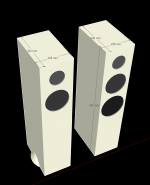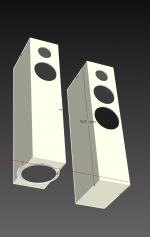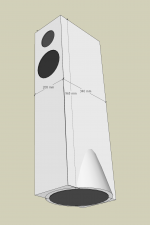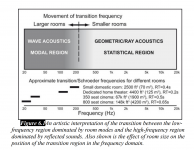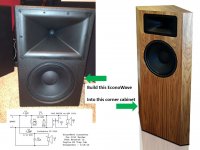This is my first post (Hi all!), but I'm reading this forum for a while and I'm really enjoing your posts guys!
I love good audio. I didn't invested a ton in audio equipment.. my gear for so far are the Monitor Audio RX6 floorstanders, the LS50 wireless speakers and Marantz SR6010. I have an 13" inch subwoofer, but I'm not using that one very often since we have a baby. The ruffle of the subwoofer is hard. That;s great for horror movies or thrillers, but in normal music listening or TV shows it's pretty annoying.
I want to move my LS50 wireless speakers to my desk and get floorstanders again in the livingroom. The constraint is that they need to be placed close to the corners. I can buy new speakers from KEF or any other manufacturer, but I think that I will enjoy the journey to develop my own speakers with higher quality components. I'm a beginner, so I have a lot to learn (and I want to learn)!
What I miss from my LS50 is the size of the soundtage. They sound nice, but they sound as small speakers. Subwoofer integration is very hard to get right. My RX6 do have a muche bigger soundstage, but lesser warmth and refinement.
They design and look of the speakers have to be modern and not that big. (I don't want to place myself in the position to have to chose between my wife or my speakers 😀) I have to place the speakers in the corers (I will post photos of the living room later).
The SBA 761 of Troels look like a good starting point, but I want to use a different tweeter (Bliesma T35B). I have shortlisted my midrange and woofer to two brands/types: Satori MW16 or the Audio Technology C-quenze 18H.
I have to different design ideas now. The speaker on the right, is almost exactly the SBA761 with the 6.5"mid-woofer and 7.5" woofers. The speaker on the left is an idea of mine: Placing a 10" (sub)woofer (for example the Audio Technology 10C77 that Troels use in other designs) in a partial cone shape and keeping the rest of the speaker small. In that case I will get rid of 7.5". The cone shape at the bottom of the left speaker will be bigger that this impression.
I think that I can get 30L volume for the 10c77. In other speakers Troels is saying that this woofer performs very well even in small size volume/cabinets. Will I get a trouble with this design choice? Things like time alignment or the corner placement of the speaker?
Which direction would you advice? Staying within the tried and verified method of the SBA 761 or try my crazy-cone-bottom-firing-bigger-woofer? Any guidance what the effect of the cone shape in the enclosure will be? How to tweak it's size to benefit form this shape?
Maybe not the main topic, but if people tested the Audio technology c-quence line VS the Satori's (Textreme or the older version), please let me know which you prefer and why!
I love good audio. I didn't invested a ton in audio equipment.. my gear for so far are the Monitor Audio RX6 floorstanders, the LS50 wireless speakers and Marantz SR6010. I have an 13" inch subwoofer, but I'm not using that one very often since we have a baby. The ruffle of the subwoofer is hard. That;s great for horror movies or thrillers, but in normal music listening or TV shows it's pretty annoying.
I want to move my LS50 wireless speakers to my desk and get floorstanders again in the livingroom. The constraint is that they need to be placed close to the corners. I can buy new speakers from KEF or any other manufacturer, but I think that I will enjoy the journey to develop my own speakers with higher quality components. I'm a beginner, so I have a lot to learn (and I want to learn)!
What I miss from my LS50 is the size of the soundtage. They sound nice, but they sound as small speakers. Subwoofer integration is very hard to get right. My RX6 do have a muche bigger soundstage, but lesser warmth and refinement.
They design and look of the speakers have to be modern and not that big. (I don't want to place myself in the position to have to chose between my wife or my speakers 😀) I have to place the speakers in the corers (I will post photos of the living room later).
The SBA 761 of Troels look like a good starting point, but I want to use a different tweeter (Bliesma T35B). I have shortlisted my midrange and woofer to two brands/types: Satori MW16 or the Audio Technology C-quenze 18H.
I have to different design ideas now. The speaker on the right, is almost exactly the SBA761 with the 6.5"mid-woofer and 7.5" woofers. The speaker on the left is an idea of mine: Placing a 10" (sub)woofer (for example the Audio Technology 10C77 that Troels use in other designs) in a partial cone shape and keeping the rest of the speaker small. In that case I will get rid of 7.5". The cone shape at the bottom of the left speaker will be bigger that this impression.
I think that I can get 30L volume for the 10c77. In other speakers Troels is saying that this woofer performs very well even in small size volume/cabinets. Will I get a trouble with this design choice? Things like time alignment or the corner placement of the speaker?
Which direction would you advice? Staying within the tried and verified method of the SBA 761 or try my crazy-cone-bottom-firing-bigger-woofer? Any guidance what the effect of the cone shape in the enclosure will be? How to tweak it's size to benefit form this shape?
Maybe not the main topic, but if people tested the Audio technology c-quence line VS the Satori's (Textreme or the older version), please let me know which you prefer and why!
Attachments
Last edited:
Have you ever designed a crossover? Do you have tools and knowledge and experience to do it?
If not then use a finished and tested plan from Troels or someone else. And don't change drivers or anything else. Just build it per plan.
You asked for advice. There it is.
If not then use a finished and tested plan from Troels or someone else. And don't change drivers or anything else. Just build it per plan.
You asked for advice. There it is.
The 2.5 way is an interesting choice, and a good one for starting out with. Each single woofer should have around the same sensitivity as the tweeter. If you can't manage that then you can always attenuate the tweeter a little, you'll probably be experimenting with that anyway.
If you want close to wall speaker placement I'm not sure a 2.5way is that suitable. They nearly always need to be brought out away from the wall. Maybe a good sealed design is best
If your goal is to do some thinking, planning, construction, soldering, and then have a ready-to-go, good sounding speaker without any trial-and-error, then follow ClassicalFan's advice. In other words, if you simply want a less expensive way to enjoy good music than buying a commercial speaker, and you are willing to spend some time sawing, building, sanding, soldering, then ClassicalFan is right.
If however, your goal is to start down the fascinating and rewarding road of experimenting with and eventually designing a pair of speakers, then you have found a home... welcome aboard, we are hear to help.
And yes, I have always been a fan of a 2.5 way system as the simplest way to get full range sound (in comparison to a 3 way). Placing them in the corner may mean balancing the frequency response a little different than is typical for a 2.5 way.
j.
If however, your goal is to start down the fascinating and rewarding road of experimenting with and eventually designing a pair of speakers, then you have found a home... welcome aboard, we are hear to help.
And yes, I have always been a fan of a 2.5 way system as the simplest way to get full range sound (in comparison to a 3 way). Placing them in the corner may mean balancing the frequency response a little different than is typical for a 2.5 way.
j.
Last edited:
Here's a very well regarded 2.5 way DIY speaker: however, I don't think it will work well in a corner:
Classix 2.5 Loudspeaker Kit - Meniscus Audio
Geoff
Classix 2.5 Loudspeaker Kit - Meniscus Audio
Geoff
The OP has not given anywhere near enough information to be able to offer a proper recommendation for a specific speaker design. He has not provide the size of the room, it’s acoustical characteristics, the listening distance, the type of music to be played, the expected SPL, etc.
In other words, there is not nearly enough information present to recommend a specific speaker model much less even a speaker type. Is a 2.5 way ported the best choice for his room? No one here really knows and it’s not clear how he even came to that choice.
What is known is that the speaker, whatever it is, has to go into a corner. And that in turn sets some rather tight limits on what will work. As Bill and Geoff both point out, a sealed design is probably going to be the best.
So the best advice to Tadaaa is to first figure out what type of speaker configuration is going to work best in your room and with all the constraints you have. From that you can start to look at other people’s designs or even try to create your own. But the starting point is the room, the speaker type, and the speaker placement, not the driver selection. That’s the wrong end of the problem.
In other words, there is not nearly enough information present to recommend a specific speaker model much less even a speaker type. Is a 2.5 way ported the best choice for his room? No one here really knows and it’s not clear how he even came to that choice.
What is known is that the speaker, whatever it is, has to go into a corner. And that in turn sets some rather tight limits on what will work. As Bill and Geoff both point out, a sealed design is probably going to be the best.
So the best advice to Tadaaa is to first figure out what type of speaker configuration is going to work best in your room and with all the constraints you have. From that you can start to look at other people’s designs or even try to create your own. But the starting point is the room, the speaker type, and the speaker placement, not the driver selection. That’s the wrong end of the problem.
Last edited:
I have an 13" inch subwoofer [...] but in normal music listening or TV shows it's pretty annoying.
You probably have it set up wrong. Lots of people want to be impressed by their subs, so they have them turned up too high relative to the mains.
IMO your first purchase should be some measuring equipment.
You can get a mic for $20 and software for $10.
Measurement Microphones
Use it to measure what you currently have, and to correct the sub levels.
It will be a good start / learning experience, and you'll use the mic again if you DIY further.
The speaker on the left is an idea of mine: Placing a 10" (sub)woofer (for example the Audio Technology 10C77 that Troels use in other designs) in a partial cone shape and keeping the rest of the speaker small.
IMO, unless your existing sub is awful, you'd be better off re-using it, so you have more budget for everything else.
Even if your sub is awful, you might be able to improve it cheaply, e.g. by bracing flimsy panels, or moving the parts to a bigger enclosure.
A quick way to test: does the sub sound different if you stack 100kg onto it? If so, the enclosure is probably a bit flimsy, and could be improved upon.
If you want close to wall speaker placement I'm not sure a 2.5way is that suitable. They nearly always need to be brought out away from the wall. Maybe a good sealed design is best
Why not both?
A 2.5 way can be a sealed design.
Last edited:
You want to add 10" subwoofers into your towers so I think that indicates a different problem.
Are your Kefs running into boundary problems? If so you need to equalize them or move them.
Also, your single woofer is absolutely a problem because it's generating unsmoothed modes. You need to build separate multi-subs not towers with subs.
How to Calibrate Multiple Subwoofers Using REW - YouTube
How to Place Multiple Subwoofers in a Home Theater - YouTube
The Geddes Multi-Subwoofer Bass Optimization Approach - YouTube
Are your Kefs running into boundary problems? If so you need to equalize them or move them.
Also, your single woofer is absolutely a problem because it's generating unsmoothed modes. You need to build separate multi-subs not towers with subs.
How to Calibrate Multiple Subwoofers Using REW - YouTube
How to Place Multiple Subwoofers in a Home Theater - YouTube
The Geddes Multi-Subwoofer Bass Optimization Approach - YouTube
Attachments
The OP has not given anywhere near enough information to be able to offer a proper recommendation for a specific speaker design. He has not provide the size of the room, it’s acoustical characteristics, the listening distance, the type of music to be played, the expected SPL, etc.
Quite right, I was just suggesting the OP had an optic at this kit to see what sort of thing is available, also, the designer's write up is well worth a read.
Apologies if this came across as my 'recommending' that speaker.
Geoff
Geoff, please no apologies are owed to anyone.
Your suggestion was a perfectly reasonable one given that the OP had shown in interest in a 2.5 way.
And you promptly pointed out that it would not be a good choice in the corner. Can't ask for anything more.
Your suggestion was a perfectly reasonable one given that the OP had shown in interest in a 2.5 way.
And you promptly pointed out that it would not be a good choice in the corner. Can't ask for anything more.
Last edited:
Do the room corners "aim" at the main listening seats? Are you open to experimenting with 90-degree horn tweeter speakers designed for corner placement? Research a few corner-design speakers.. a 12" econo wave design in a corner cabinet shape. ported -F3 ~50Hz
Attachments
If however, your goal is to start down the fascinating and rewarding road of experimenting with and eventually designing a pair of speakers, then you have found a home... welcome aboard, we are hear to help.
j.
Exactly this! I'm really willing to learn this stuff and I will be more than happy to invest time (and money) to learn.
If any one of you have a great staring point (books/ebook, youtube channel, etc for bigginners, please let me know!)
One of the best books to get started is "Loudspeaker Design Cookbook" by Vance Dickason, currently in 7th edition I believe.
As you learn and develop understanding, other books and online resources will fill in the gaps and clarify some assumptions made in this book... Experts sometimes like to belittle this book, but for a beginner, it is a fine start.
Also, Wintermute has a very good thread you should read
So you want to design your own speaker from scratch!
j.
As you learn and develop understanding, other books and online resources will fill in the gaps and clarify some assumptions made in this book... Experts sometimes like to belittle this book, but for a beginner, it is a fine start.
Also, Wintermute has a very good thread you should read
So you want to design your own speaker from scratch!
j.
Here's a very well regarded 2.5 way DIY speaker: however, I don't think it will work well in a corner:
Classix 2.5 Loudspeaker Kit - Meniscus Audio
Geoff
Agreed. These are awesome, very affordable musical speakers. Have built and still use a pair of these in the rumpus. However, they have their SPL limitations due to the DC160 woofers. Wouldn't recommend for HT use.
Since the OP has never defined any of his requirements - room size, listening position, type of music, SPL desired, etc. - it is pretty much impossible to make a recommendation. Moreover, he has said that these speakers have to go into corners, which really limits the choices.
Dedicated corner speakers are great, but they are not for the beginner. It becomes a question of how far out do they need to be before they aren't corner positioned any more.
Exactly my point. Rather than ask questions, like which of these drivers is better, he should be defining the problem in its major terms, and getting people to help by suggesting what type of speaker alignment will be best suited for his listening environment.
But like so many newbies here, they think they already know the answer without ever defining the problem.
But like so many newbies here, they think they already know the answer without ever defining the problem.
- Home
- Loudspeakers
- Multi-Way
- Beginner modern 2.5 way design
